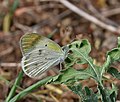
Cepora nerissa, the common gull, is a small to medium-sized butterfly of the family Pieridae, that is, the yellows and whites, which is native to Sri Lanka, India, China, southeast Asia, and Indonesia.

Ixias marianne, the white orange tip, is a small butterfly of the family Pieridae, found in India and Sri Lanka.

Ixias pyrene, the yellow orange tip, is a small butterfly of the family Pieridae, that is, the yellows and whites, which is found in Sri Lanka, India and southeast Asia.

Hebomoia glaucippe, the great orange-tip, is a butterfly belonging to the family Pieridae, that is the yellows and whites. It is found in the Indomalayan realm and Wallacea.

Pontia chloridice, the lesser Bath white, is a small butterfly of the family Pieridae, that is, the yellows and whites. The species is found in steppe zone of Ukraine, Moldova and Russia; east to Transbaikalia, Mongolia, Korea; south to Balkan Peninsula, Turkey, Transcaucasia, Greater Caucasus, Iran, Northern Pakistan, Central Asia, Kazakhstan.

Colotis amata, the small salmon Arab, is a small butterfly of the family Pieridae, that is, the yellows and whites. It is found in Africa and Asia. Adults are fond of smaller flowers for nectar and often fly low along the ground in search of wildflowers.

Colotis phisadia, the blue-spotted Arab, is a small butterfly of the family Pieridae, that is, the yellows and whites, which is found in Mauritania, Senegal, Mali, Nigeria, Niger, Chad, Sudan, Ethiopia, Kenya, Kuwait, Uganda, Arabia, the Near East and India.

Colotis vestalis, the white Arab, is a small butterfly of the family Pieridae, that is, the yellows and whites, which is found in India, Pakistan, Iran, Somalia, Ethiopia, Sudan, Kenya and Tanzania. It has a wingspan of 4–5 cm.

Colotis fausta, the large salmon Arab, is a small butterfly of the family Pieridae, that is, the yellows and whites, which is found in Israel, Syria, Turkey, Iran, Afghanistan, Turkmenistan, India, Arabia, Chad, Somalia and United Arab Emirates.

Cepora nadina, the lesser gull, is a small to medium-sized butterfly of the family Pieridae, that is, the yellows and whites. The species was first described by Hippolyte Lucas in 1852. It is native to Sri Lanka, India, Myanmar, Hainan, and southeast Asia.

Colotis danae, the crimson tip or scarlet tip, is a small butterfly of the family Pieridae, that is, the yellows and whites. It is found in Asia and Africa.
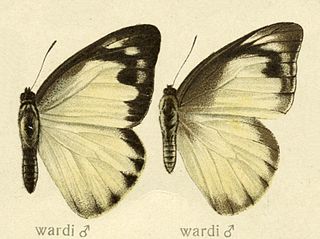
Appias wardii, the Indian albatross or Ward's albatross, is a small butterfly of the family Pieridae, that is, the yellows and whites, which is found in India.
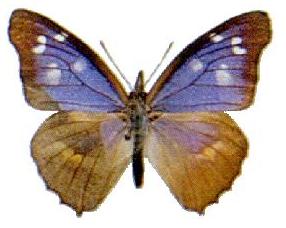
Libythea geoffroy, the purple beak, is a butterfly found in parts of India and Myanmar that belongs to the subfamily Libytheinae of the family Nymphalidae.
Celastrina albocoeruleus, the albocerulean, is a small butterfly found in India that belongs to the lycaenids or blues family.
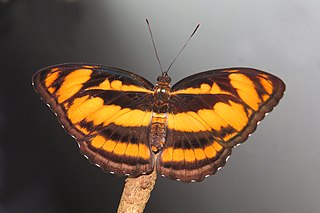
Athyma nefte, the colour sergeant, is a species of brush-footed butterfly found in tropical South and Southeast Asia.

Vindula erota, the common cruiser, is a species of nymphalid butterfly found in forested areas of tropical South Asia and Southeast Asia.

The Indian fritillary is a species of butterfly of the nymphalid or brush-footed family. It is usually found from south and southeast Asia to Australia.

Libythea celtis, the European beak or nettle-tree butterfly, is a butterfly of the Libytheinae group of the brush-footed butterflies family.
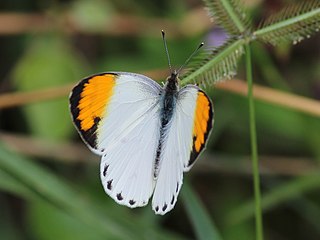
Colotis aurora, the sulphur orange tip or plain orange-tip, is a butterfly in the family Pieridae. It is found in Asia and Africa. The nominate subspecies, Colotis aurora aurora is found in India and Sri Lanka. The other subspecies, Colotis aurora evarne is found in Mauritania, Senegal, the Gambia, Mali, Burkina Faso, Ghana, Benin, Nigeria, Chad, Sudan, Ethiopia, Uganda, Kenya, Rwanda, Tanzania, the Democratic Republic of the Congo, Somalia, and southern Arabia.

Pareronia hippia, the common wanderer or Indian wanderer, is a medium-sized butterfly of the family Pieridae, that is, the yellows and whites. It is found in India. Some authors consider this as a subspecies of Pareronia valeria.

